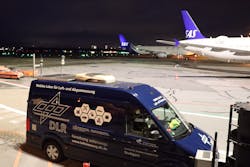Large-Scale International Experiment at Copenhagen Airport Shows Biofuel Improves Air Quality
Bio-based aviation fuel reduces the number of ultrafine particles, improving air quality. That is one of the conclusions drawn from a large-scale international experiment at Copenhagen Airport.
Researchers measured an aircraft with 34 percent bio-based fuel, SAF, in the tank while it was taxiing between the runway and the gate at the airport. Ground measurements show a reduction in the emission of ultrafine particles by about 30 percent.
"These are really good news. It's an important discovery that sustainable aviation fuel has an impact on air quality. We already know that it helps reduce CO2 emissions, so this is another significant benefit of transitioning aviation to sustainable fuels," said Christian Poulsen, Acting CEO at Copenhagen Airport.
Complex Measurements in a Unique Experiment
This is a completely unique experiment that took place over a period of four weeks during the winter. It's the first time ever that such extensive measurements have been conducted in an authentic airport environment, making it a highly complex experiment.
”When you move your research and experiments out of the laboratory, everything becomes much more complex. It's impressive how the researchers have managed to carry out the measurements in a large, fully operational airport, where factors like wind and changing temperatures have a significant impact on the measurements," said Poulsen.
The measurements were conducted by researchers from DLR, The German Aerospace Center. During the experiment, they set up a mobile laboratory filled with advanced measuring equipment at a gate in Copenhagen Airport. From there, they measured air quality when an SAS aircraft with 34 percent SAF blended in its fuel tank arrived in Copenhagen from Stockholm three to four times daily. The measurements were taken while the aircraft was on the ground and taxiing between the runway and the gate.
“This experimental setting under real airport operations leads to a significantly higher complexity compared to classic test bench measurements due to the influence of numerous environmental factors such as wind, different temperatures, etc. All these variables required thorough consideration during both data collection and subsequent analysis. Nonetheless, the experimental results confirm the favorable impact of SAF on ultrafine particles and thus local air quality as already indicated in laboratory scale experiments – even under such complex conditions,” said Benedict Enderle, Senior Scientist, DLR.
More Benefits of SAF
Airline SAS provided an Airbus A320 for the four-week-long experiment, and they are also very pleased with the results.
“We at SAS, are very proud of our participation in this project, it’s a great example of how our collective efforts can enable further discoveries of sustainable solutions for the aviation industry. The findings of this unique experiment at Copenhagen Airport underscore that SAF – sustainable aviation fuel – serves not only to reduce CO2 emissions but also to reduce the impact of contrails, and enhancing local air quality,” said Ann-Sofie Hölin, Head of Sustainability, SAS.
The results of the measurements provide the most detailed picture to date of the effect of using SAF, sustainable aviation fuel, on local air quality at the airport.
"At Copenhagen Airport, we are constantly looking for ways to reduce harmful emissions from aircraft and improve air quality. We have been working on this since 2007, considering the environment, our neighbors, and the employees working around the aircraft. That's why we are also looking forward to more airlines starting to fly with sustainable aviation fuel in their tanks," said Poulsen.
EU Requirements for SAF in 2025
Starting from 2025, there will be a requirement that all aircraft departing from an EU airport must have a 2 percent blend of SAF. The blending requirement will steadily increase towards 2050, where a 70 percent blending is mandated.
"The EU agreement is a crucial step towards a green transformation of aviation. But it also emphasizes the need to kickstart the production of sustainable aviation fuels. We will need development and production to achieve our common goals for transforming the entire aviation industry," said Poulsen.
The experiment and measurements of air quality when flying on SAF are part of many important activities in the EU project ALIGHT, where Copenhagen Airport serves as a flagship airport. Seventeen European partners are gathering experiences and knowledge to find future solutions for a more sustainable aviation.
Facts about SAF
Sustainable aviation fuel, or SAF, is a cleaner alternative to conventional aviation fuel that reduces CO2 emissions. There are two types of SAF: Bio SAF and Synthetic SAF. Bio SAF is produced from waste products like used cooking oil, waste oil, and fats, while Synthetic SAF is produced using the Power-to-X technology, where renewable energy is used to split water and add carbon dioxide (CO2), creating sustainable aviation fuel. Currently, Bio SAF is the only sustainable aviation fuel on the market, but it is expected that Synthetic SAF will be the future solution.
Facts about ALIGHT
ALIGHT is an EU-funded project where 17 different partners gather knowledge and experiences to find future solutions for a more sustainable aviation. Among the partners are European universities, SAS, Germany's Aerospace Center, the International Air Transport Association (IATA), and four European airports. The goal is to share the knowledge and experiences gained from the project with other European airports so that the entire industry can learn from the results and be inspired to a sustainable transition.
